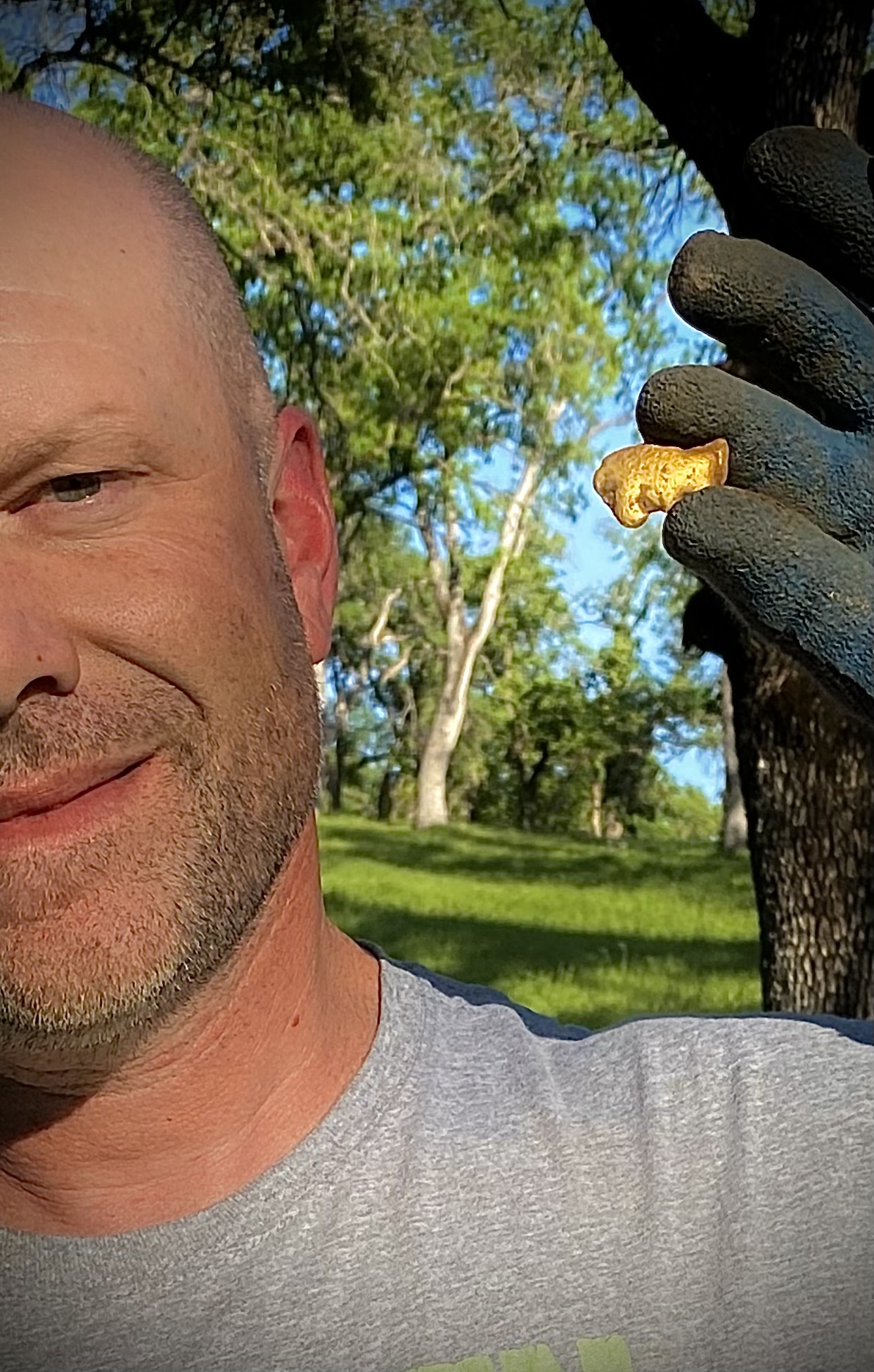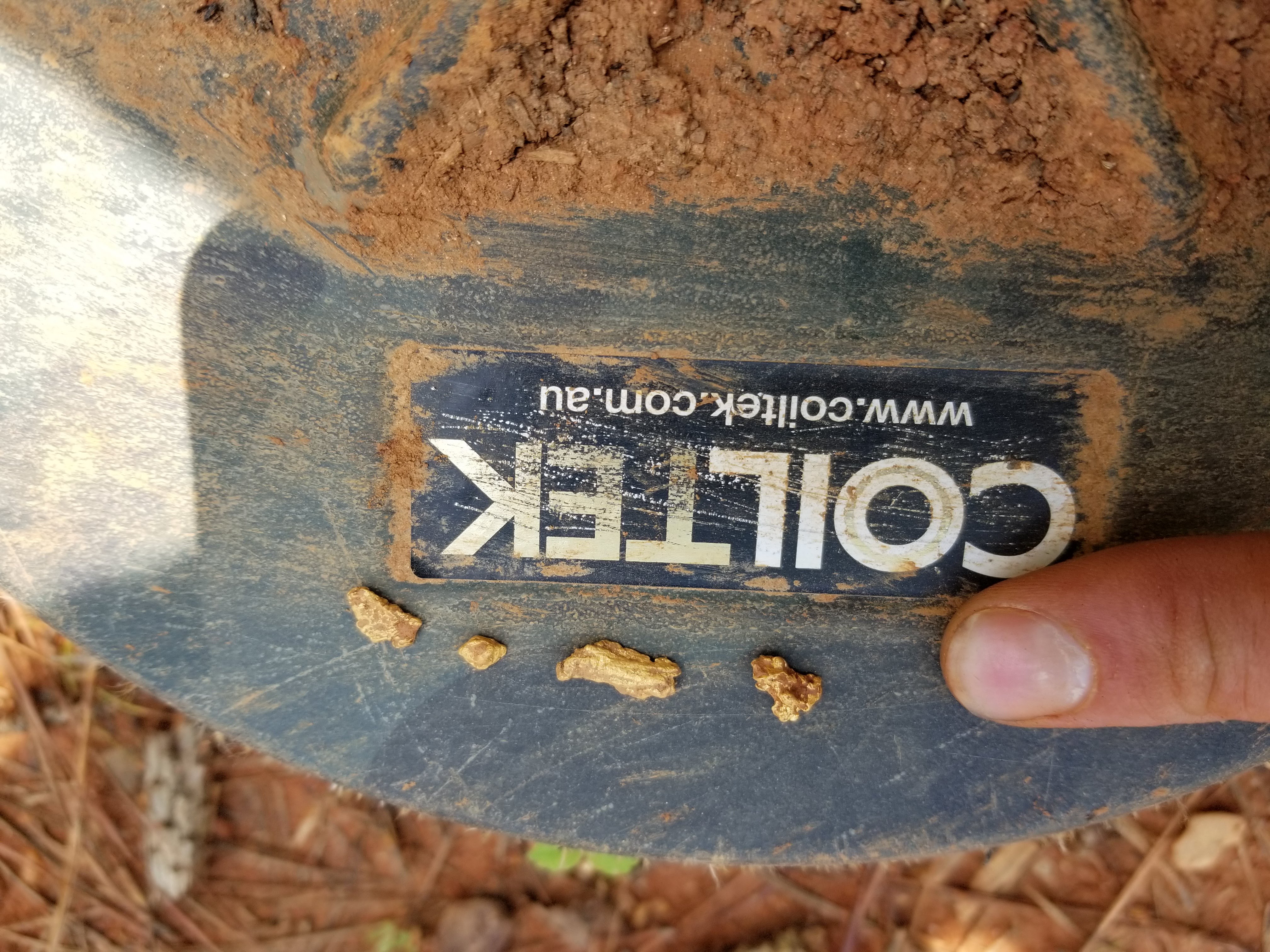Prospecting & Detecting
PLP Update: Back to The 'Swamp' on Behalf of Small Miners
July 2018 by Scott Harn
I arrived back in Washington, DC, around 6pm on June 4 for another week of meetings with legislators and with various federal agencies in our ongoing quest to seek regulatory relief for small miners. Clark Pearson of Public Lands for the People landed at Reagan International about two hours later and we headed off to our hotel.
This time we came armed with letters of support and proposed solutions from ICMJ readers across the country.
This was our third trip to DC in the past 15 months. On previous trips, we received conflicting information from members of Congress on how to proceed. Members of the US Geological Survey agreed with us that critical and strategic minerals are a matter of national security. America has become reliant on unfriendly countries that control the production and distribution of many critical and strategic minerals, and for some we are 100% reliant with no US-based production.
Back in 2016, the Minerals and Mining Advisory Council and Public Lands for the People were instructed to try to get critical and strategic minerals included in the National Defense Authorization Act (NDAA). This was the chosen path for the first few visits to Congress. However, in 2017, after a few visits to DC, several members of Congress asked us to redirect our efforts and use the traditional process that involves putting a bill through the House Committee on Natural Resources and the Senate Committee on Energy and Natural Resources.
Clark rewrote our proposal as “Small Miner Amendments to S-145,” which was a minerals bill proposed by Senator Dean Heller (R-NV). Congressman Trent Franks’ (R-AZ) staff had been very helpful. He liked our proposals and his staff submitted them to Legislative Council for review twice, which is something all bills and amendments go through for a legal review. However, Franks abruptly resigned at the end of 2017 following allegations of sexual harassment, so we were starting over trying to find a sponsor.
We met Senator Heller’s legislative director in March 2018 and reviewed the proposed amendments and everything seemed to be on track. I contacted Senator Heller’s staff by email prior to this latest trip so we could meet again and answer any questions they might have.
 Just before we headed to DC, we learned the Senate Committee on Energy and Natural Resources, chaired by Senator Lisa Murkowski (R-AK), had given their blessing to include Senator Heller’s bill in the NDAA. Apparently, they like the NDAA idea we had pushed for on previous visits. While Senator Heller’s legislation provides a little relief for big mining concerns, it still will require a company or individual to sue federal agencies for permit delays beyond thirty months, and it still lacks regulatory relief for small miners.
Just before we headed to DC, we learned the Senate Committee on Energy and Natural Resources, chaired by Senator Lisa Murkowski (R-AK), had given their blessing to include Senator Heller’s bill in the NDAA. Apparently, they like the NDAA idea we had pushed for on previous visits. While Senator Heller’s legislation provides a little relief for big mining concerns, it still will require a company or individual to sue federal agencies for permit delays beyond thirty months, and it still lacks regulatory relief for small miners.
Clark changed the title of our proposal from “Small Miner Amendments to S-145” to “Small Miner Amendments to NDAA” and made revised copies for this trip.
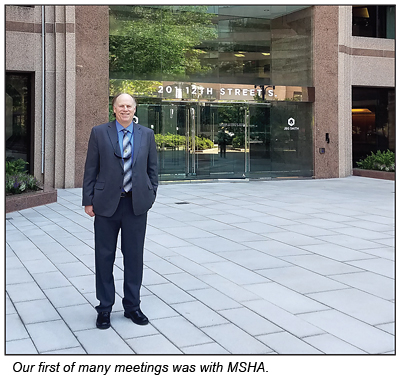 Tuesday, June 5
Tuesday, June 5
We met with the top three officials at the Mine Safety and Health Administration, Emily Hargrove, Brian Goepfert, and Acting Administrator Keven Stricklin.
Here are some excerpts from the cover letter I provided:
As I’m sure you are aware, President Trump issued Executive Order 13777 on February 24, 2017, titled “Enforcing the Regulatory Reform Agenda.” The President declared, “It is the policy of the United States to alleviate unnecessary regulatory burdens placed on the American people.”
President Trump directed agencies, including MSHA, to review existing regulations, and to “seek input and other assistance…from entities significantly affected by federal regulations, including state, local, and tribal governments, small businesses, consumers, non-governmental organizations, and trade associations.”
Clark Pearson of Public Lands for the People and I have spoken with hundreds of miners regarding major issues impacting small miners across the United States in their dealings with MSHA. In addition, I solicited comments from our readers regarding regulatory reform that could help “alleviate unnecessary regulatory burdens placed on the American people.”
100% of the commenters stated that MSHA is wholly inappropriate for self-employed operators or those who employ only family members. OSHA statutes correctly made a distinction between large operators and self-employed operators.
MSHA should immediately exclude small operators from MSHA requirements to make the agency consistent with OSHA and comply with Executive Order 13777.
These complaint letters highlight some of the main issues facing small-scale miners and prospectors in America today in regards to MSHA.
There are several actions you can take immediately that will help the agency comply with Executive Order 13777, “alleviate unnecessary regulatory burdens” on small miners across America, help to create American jobs and save millions of taxpayer dollars at the same time. The first such action should be to exempt small mine operators from MSHA.
Our discussions centered on the adversarial relationship between MSHA and small miners, along with the difficulty faced by sole operators and small operations in complying with SARs (Search and Rescue) team requirements. Small miners with underground operations are required to have access to SARs services.
In the past, small miners were able to utilize regional SARs teams. Today, for many operators in northern California, the nearest such teams are located across the border in Nevada. However, MSHA personnel in northern California (Vacaville) had told several northern California miners they could not utilize a SARs team located in another state so they are therefore unable to comply with the requirement.
Stricklin stated miners should not be limited to utilizing teams within their home state, and this was later remedied with a phone call by MSHA to the northern California office after the meeting.
The majority of complaints we brought to the agency dealt with the treatment of small miners. Some miners felt harassed by field personnel and we also wanted to know why a self-employed miner with no employees was being treated like Barrick or Newmont.
Stricklin stated the agencies hands are tied when it comes to issuing citations—there is no provision in MSHA regulations for discretion. He suggested we seek assistance from Congress to exempt sole operators or family operations. (We plan to do exactly that—more on this point later.)
Regarding the interactions between field personnel and miners, Stricklin said he was aware of some complaints regarding a particular employee in northern California,but that person is no longer employed there. He pledged to keep an open dialogue with us and said he was certainly open to coordinating meetings between miners and regional offices.
The meeting was cordial and some good discussions were had about a variety of topics.
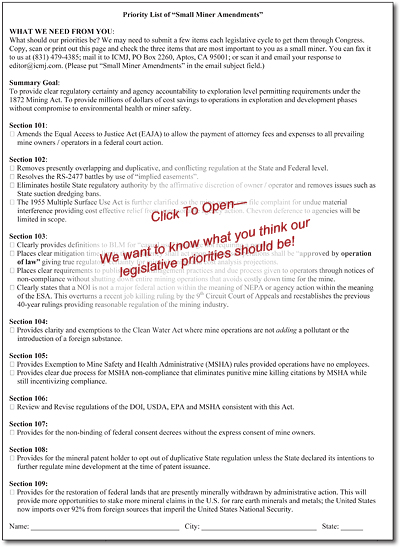 We have a provision in our proposed small miner amendments that addresses excluding sole operators and family operations from MSHA. We will be continuing to push for these changes with members of Congress.
We have a provision in our proposed small miner amendments that addresses excluding sole operators and family operations from MSHA. We will be continuing to push for these changes with members of Congress.
I hadn’t received any response from Senator Heller’s staff from the previous week, so we headed over there to announce our presence and get an appointment. The staff said they would reach out to us by email to arrange a meeting.
We needed to revise our game plan since Heller’s bill had been moved to the NDAA and the House had already approved their version. We were caught a little off guard by the move, and also because the NDAA was being moved much earlier than it was the previous year. (In 2017, the NDAA debate began in July and wasn’t approved until December 2017.)
We had some ideas, but we needed someone knowledgeable to guide us through the process. So, we went ahead and began dropping by the offices of Senators who are on the Armed Services Committee, which is the first stop for the NDAA.
Wednesday, June 6
We had a really good meeting with Congressman Paul Gosar’s (R-AZ) staff in the House. They really liked our proposed amendments but the House version of the NDAA for this cycle had already been passed.
They suggested we shoot for just a few items rather than the five-page proposal to try to get something into the NDAA this year, and go for the additional items in subsequent NDAA cycles.
Clark and I got to work, and we picked a few of the most pressing amendments to shoot for. The ones we selected included reopening closed roads and routes, allowing the small miner the option of choosing state or federal regulation, exempting operations without employees, and allowing mining claimants to petition the Bureau of Land Management for material interference with prospecting, mining or processing operations.
 What we needed at this juncture was someone with clout on the Senate Energy and Resource Committee to approve of our efforts and get them moved to the NDAA. We had met with Senator Mike Lee (R-UT) personally on two previous trips. He and his staff were knowledgeable and helpful, but we couldn’t get an appointment with his office until the following afternoon.
What we needed at this juncture was someone with clout on the Senate Energy and Resource Committee to approve of our efforts and get them moved to the NDAA. We had met with Senator Mike Lee (R-UT) personally on two previous trips. He and his staff were knowledgeable and helpful, but we couldn’t get an appointment with his office until the following afternoon.
We spent the remainder of Wednesday meeting with a couple of the Senators on the Armed Services Committee to review our proposed amendments, and we worked on emails to the remaining members until almost midnight.
Thursday, June 7
We spent the morning in a meeting with one of the higher-ups at the US Forest Service. I presented him with 412 complaints received from our readers, along with a summary of the complaints to make his job easier. Clark followed up with some specific complaints regarding historic cabins that have been nominated as historic but the Forest Service continues to threaten to demolish and remove them.
An excerpt of my cover letter:
As I’m sure you are aware, President Trump issued Executive Order 13777 on February 24, 2017, titled “Enforcing the Regulatory Reform Agenda.” The President declared, “It is the policy of the United States to alleviate unnecessary regulatory burdens placed on the American people.”
99% (408 respondents) stated they did not receive notification from the US Forest Service regarding proposed Travel Management Plans even though their mining claim information was on file and readily available via mining claim filings through the Bureau of Land Management.
96% (395 respondents) mentioned access to valid, existing mining claims and to potentially valuable mineral or metal resources is being outright blocked or obstructed by USFS District Rangers or personnel in the field who denied access by blocking the route with boulders, fallen trees, access gates, or by removing the trail, route or road from the list of approved routes and requiring a Notice or Plan to restore access.
95% (391 respondents) stated they were unaware that Travel Management Plans proposed by the US Forest Service would obstruct access to their exploration, mining claims or operations, even though the “best available information” requirement should have required notification to valid, existing claimholders.
79% (325 respondents) complained the US Forest Service interpretation of what constitutes a “significant disturbance” is “overbroad,” “overboard,” “unreasonable,” and “defies common sense.”
There is also a small number who stated the US Forest Service was threatening to remove historic mining cabins—including some that are over 100 years old—from their valid, existing claims, and this includes cabins that have been nominated as historic buildings.
This was a lot of information for him to process, but he pledged to work with us to get these problems corrected. He noted that he does not have the personnel he needs to carry out President Trump’s plans because confirmations are still being held up by Democrats in the Senate.
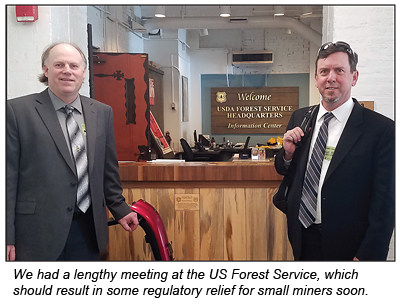 We have continued to stay in contact since returning from DC, and we have begun to work on several of these issues to provide relief for small miners. I’ll certainly keep you posted.
We have continued to stay in contact since returning from DC, and we have begun to work on several of these issues to provide relief for small miners. I’ll certainly keep you posted.
We spent the rest of the day in meetings with staff members for various Senators on the Armed Services Committee, and also met with two members of Senator Mike Lee’s staff.
There is so much turnover and so many reassignments in DC each year that it becomes difficult to develop a relationship with staff members. Both of Senator Lee’s staff members had not seen our proposed amendments even though we met with the Senator on two prior occasions. They seemed to understand the material but wanted time to dig deeper into the changes we were proposing.
We also met with two staff members for Senator James Inhofe (R-OK). His office was handling NDAA-related issues in the absence of Senator John McCain (R-AZ), who is on medical leave. They invited us into the NDAA “war room” where all the amendments were being processed and reviewed. They were very supportive and stated they would be waiting for Senator Lee’s staff to submit the material so it could be included.
The last activity of the evening involved an email from Senator Heller’s staff. Despite receiving our appointment request a full week earlier, they stated they did not have time to meet with us. My response was not very polite.
Friday, June 8
We spent the entire day briefing Senators on the Armed Services Committee, and we also checked in numerous times with the staff of Senator Lee and Senator Inhofe in case there were any questions. Senator Lee’s staff assured us they were still reviewing the material and would continue looking at it through the following week. We spent our last evening in DC cautiously optimistic that our proposed amendments would make it into the NDAA.
We had also hoped to meet with one of the deputy directors at the EPA to follow up on a clarification letter we requested in March. We weren’t able to arrange this meeting because the upper level staff were all in Idaho for the week, and we didn’t have much time to spare regardless.
Our correspondence continued daily with Senator Lee’s staff the following week, and then I received this message on Wednesday, 6/13:
We did not file the proposed small miner amendments because we had already established our priorities and strategy for the NDAA before you came to us with your proposals. …All of the amendments Senator Lee filed to the NDAA have been weeks, months, and in some cases years, in the making. We are very careful about the bills and amendments he files and we insist on having a thorough understanding of everything he endorses. Because of our established priorities and the limited amount of time we had to vet the small miner amendments, we ultimately were not comfortable recommending the Senator file them.
I am happy to continue learning more about these proposals and working with you to relieve the regulatory burdens on small miners.
Here was my response:
Just to clarify a few things for you…
We’ve been at this for three years—nine week-long trips to DC.
Clark Pearson and I met with Senator Lee himself in March 2017 and again in March 2018 along with [name omitted] who arranged the meetings. We presented the full list of proposed amendments, which seems like plenty of time to vet them.
The only change during that time was slight rewording when they came out of Legislative Council on the House side.
We pared it down from five pages to just a single page containing the most critical issues in hopes the end result would be at least minor progress in providing relief from over-zealous regulations.
As I’m sure you are aware, it’s likely impossible to get a standalone bill of this nature through. With a few Republican Senators who don’t always vote as desired, 10 or so Democrats would be needed in the Senate and that’s not going to happen in the current climate. I pray that we hold onto the House and Senate during mid-terms.
I’m going to wait until my anger subsides to write my article about the lack of progress.
What’s Next?
We are pleased the big miners got what they felt they needed from Senator Heller, but it’s very unfortunate his staff would not consider helping the small-scale folks. It’s not a good move, especially in an election year. It took Senator Heller six years to get his bill through; we’ve been at it for three years now. The good part is that they took our recommendation and established a critical and strategic minerals section in the NDAA. It will remain there, which will make it easier for us to get some of our proposed amendments in the next NDAA cycle.
We have some momentum established with members of the House and Senate who like our proposals and several who have pledged their support. We have some good dialogue going with MSHA and clarity on the SARs teams issue, and someone at the USDA Forest Service that can provide some regulatory relief as we continue to work with him over the next couple of months. We are certainly not going to stop until we get some regulatory relief for the small miner.
I want to thank all of our readers who sent in emails and letters for me to deliver in DC—they made a strong impression that will last and they will be used again.
With your continued support, we are convinced that persistence will eventually pay off.
Prospecting for Liberated Gold
 Some will doubt its value given the ultra-fine particle size… Some will become encouraged about not having to incur significant time and expense to break rock.
Some will doubt its value given the ultra-fine particle size… Some will become encouraged about not having to incur significant time and expense to break rock.
Prospecting Underground: Use Caution
In underground placer work, the contact point of the bedrock tunnel and the gravel is a very weak point and always has to be timbered. The bedrock here is thin, fractured, and the gravels loose from many years of oxidizing.
Pickers and Nuggets
 Mike and I each selected a side of the creek and started to work our way upstream. We both worked the water and sides of the creek, and better than half the gold found in this area is in the water.
Mike and I each selected a side of the creek and started to work our way upstream. We both worked the water and sides of the creek, and better than half the gold found in this area is in the water.
Creating Your Own Luck
Now that you are actually going to be out there doing some prospecting, I may be able to help.
The Highs and Lows of Drywashing
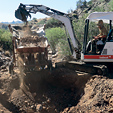 We were met with a plethora of mechanical problems with the dry washer and even a few with the excavator that were at times frustrating, but we were in this for the long haul, so we needed to solve these problems and move forward.
We were met with a plethora of mechanical problems with the dry washer and even a few with the excavator that were at times frustrating, but we were in this for the long haul, so we needed to solve these problems and move forward.
Subscription Required:
The Bawl Mill
• Ask The Experts - How were those gold concentrate bricks made?
• Ask The Experts - What should I know about prospecting for titanium?
• Mining Pegmatite Deposits
• Legislative and Regulatory Update
• SS Central America Gives Up Millions in Gold Rush Era Gold
• Falcon Fanatic: Journey of a Novice Detectorist
• Las Médulas—The Gem of the Roman Gold Mines
• Critical Minerals: Titanium
• Melman on Gold & Silver
• Mining Stock Quotes and Mineral & Metal Prices
Free:


